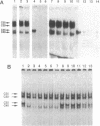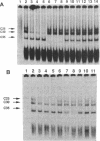Abstract
Two DNA elements which we have termed SAA and GAG have been shown to control expression of the rat amyloid precursor protein (APP) gene, and the region containing the SAA element has been shown to interact with nuclear proteins [Hoffman and Chernak (1994) Biochem. Biophys. Res. Commun. 201, 610-617]. In this report we study DNA sequences and proteins which influence the activity of the SAA element. An oligonucleotide containing the SAA element is specifically bound by nuclear proteins derived from rat PC12 cells, consistently forming four complexes designated C25, C30, C35 and C40 in electrophoretic mobility shift assays (EMSAs). We demonstrate that the C25, C30 and C40 complexes involve the binding of nuclear proteins to an SP1 consensus sequence located within the SAA element and that the C25 complex contains a protein antigenically related to the human SP1 protein. We establish further that the C35 complex requires a USF recognition site located within the SAA element and contains a protein antigenically related to the human upstream stimulatory factor (USF) protein. Using APP promoter/luciferase reporter gene constructs, we demonstrate that both the SP1 and the USF sites can play a role in the transcriptional activity of the SAA element. Finally, we show that complexes similar to the C25, C30 and C35 complexes are formed by rat cortex nuclear extracts and the SAA element in EMSA experiments, suggesting the relevance of our in vitro observations to the in vivo functioning of the rat APP promoter.
Full text
PDF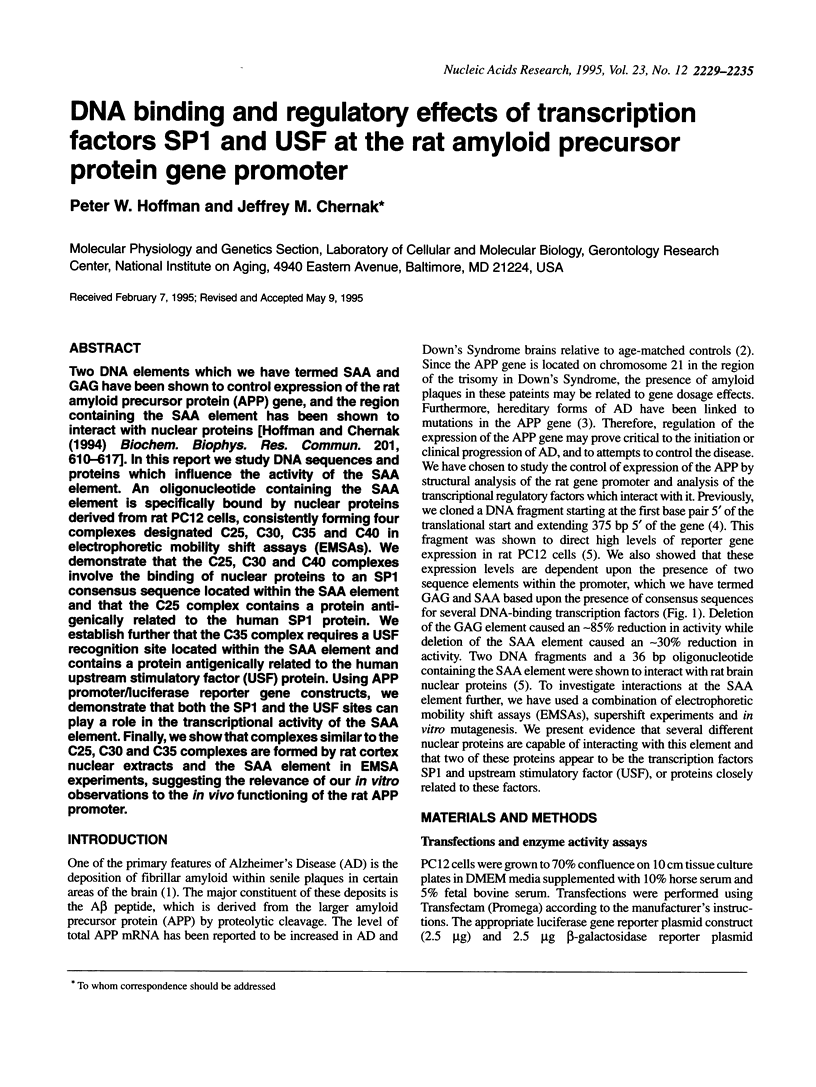
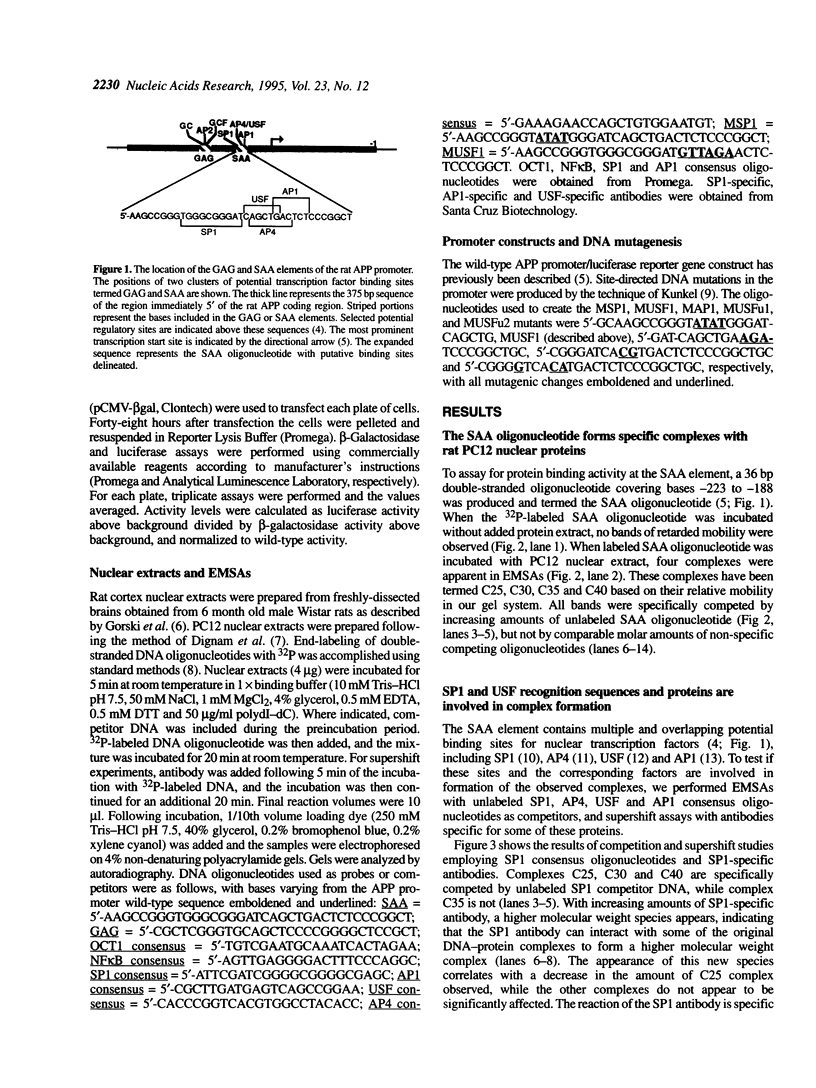
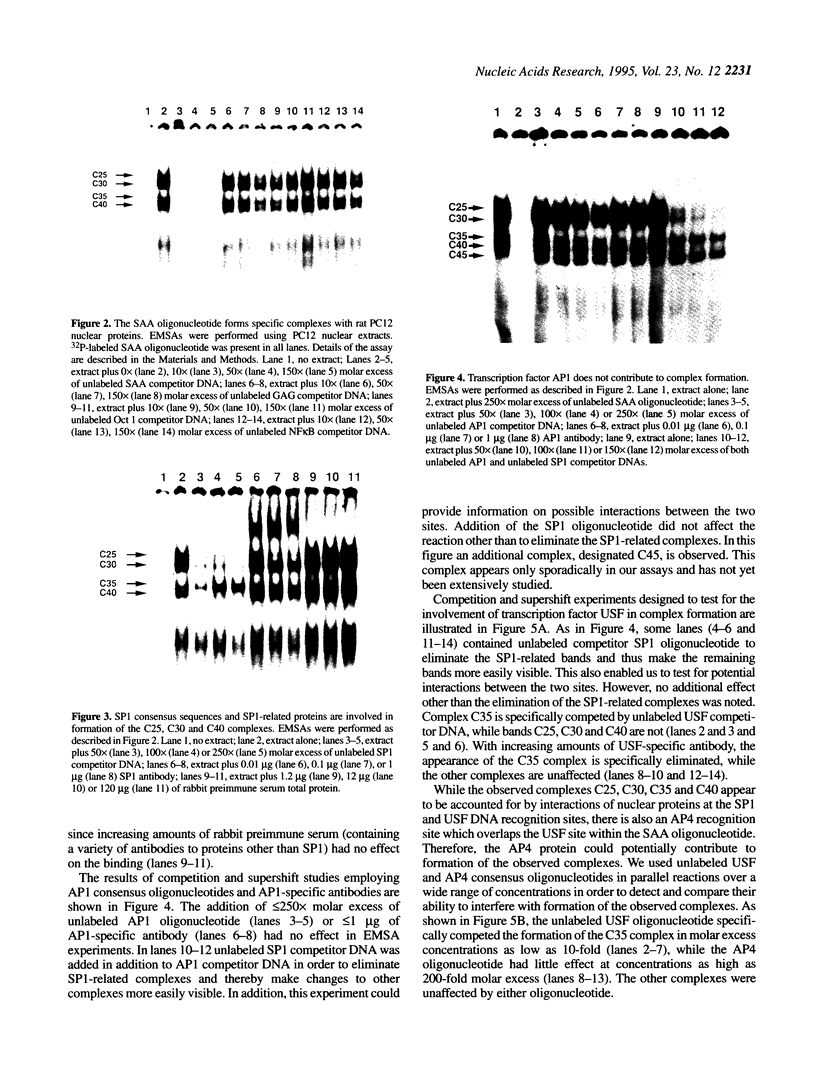
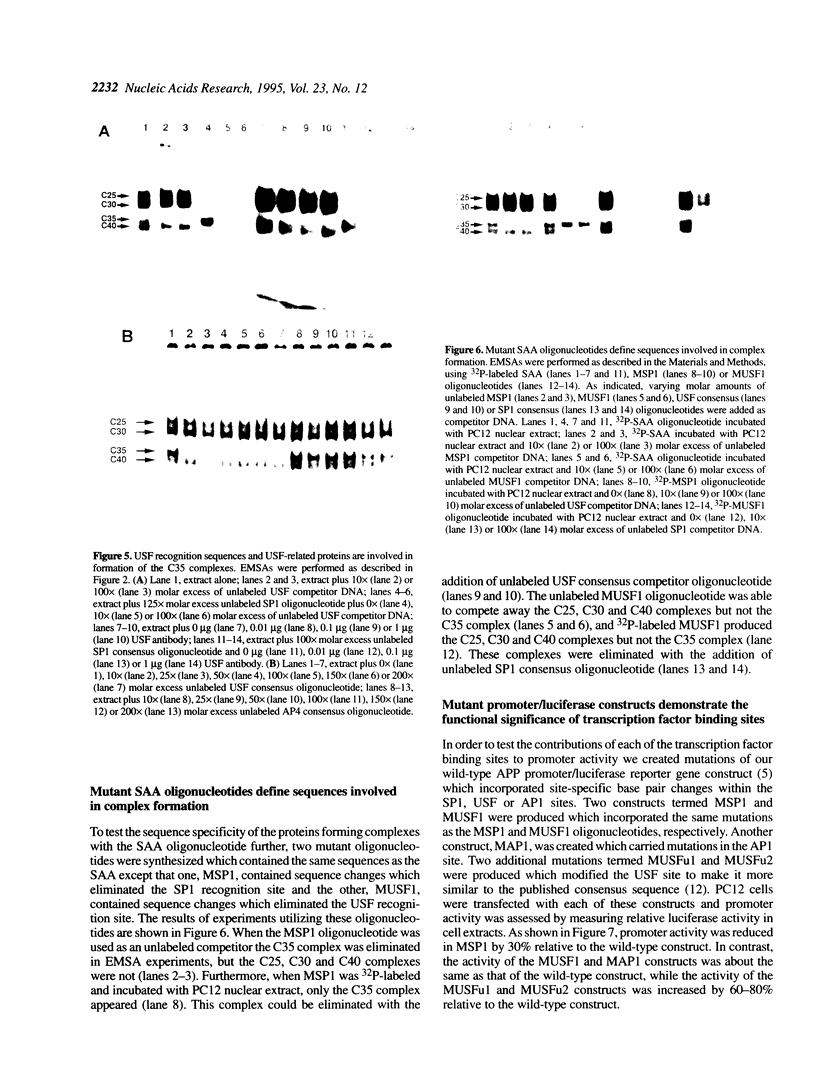
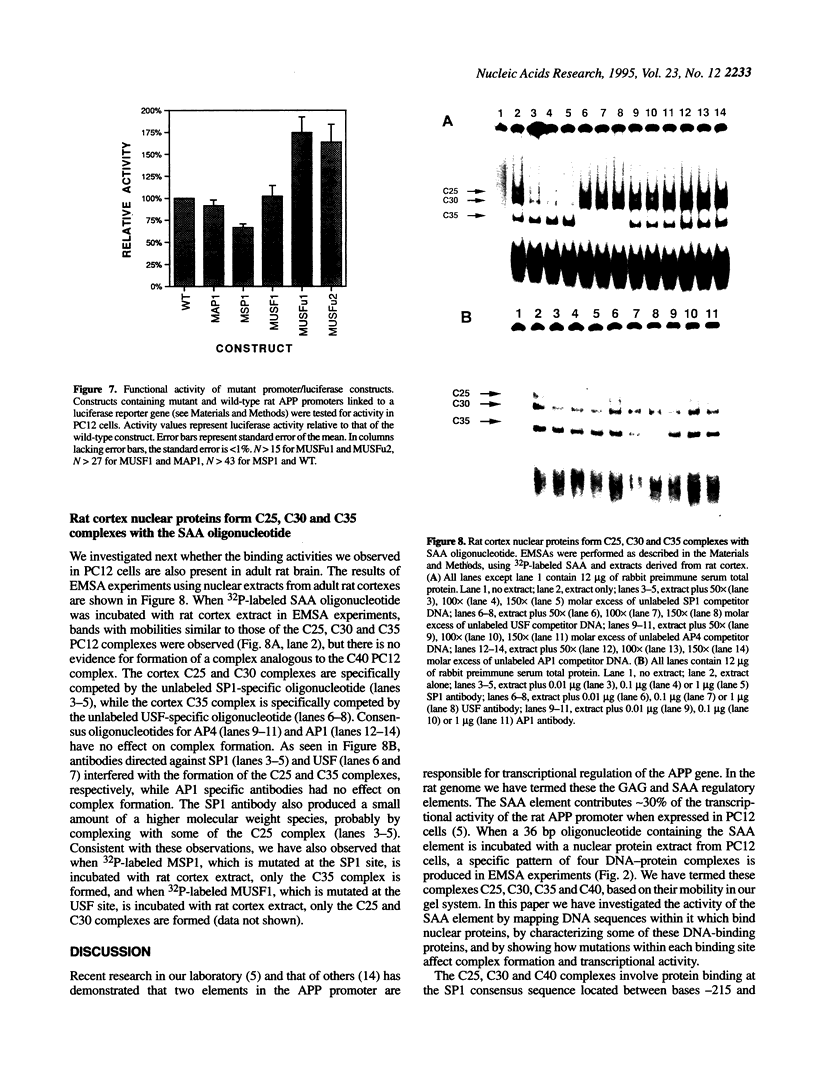
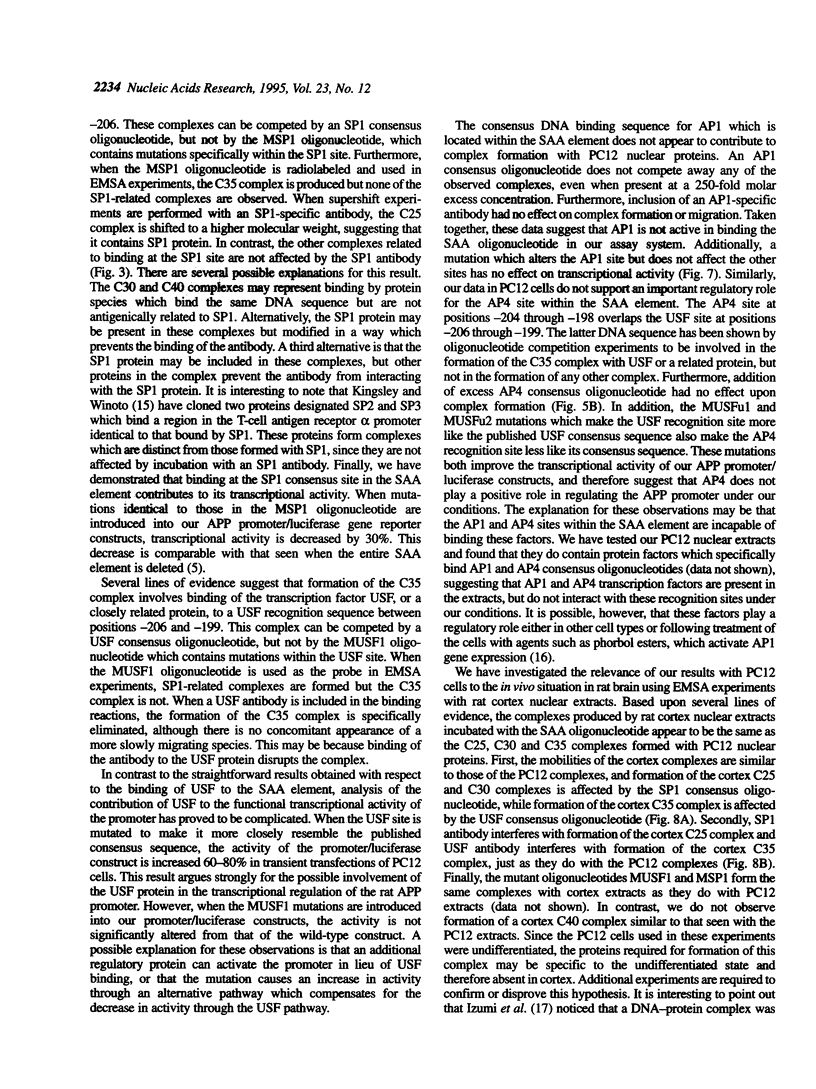
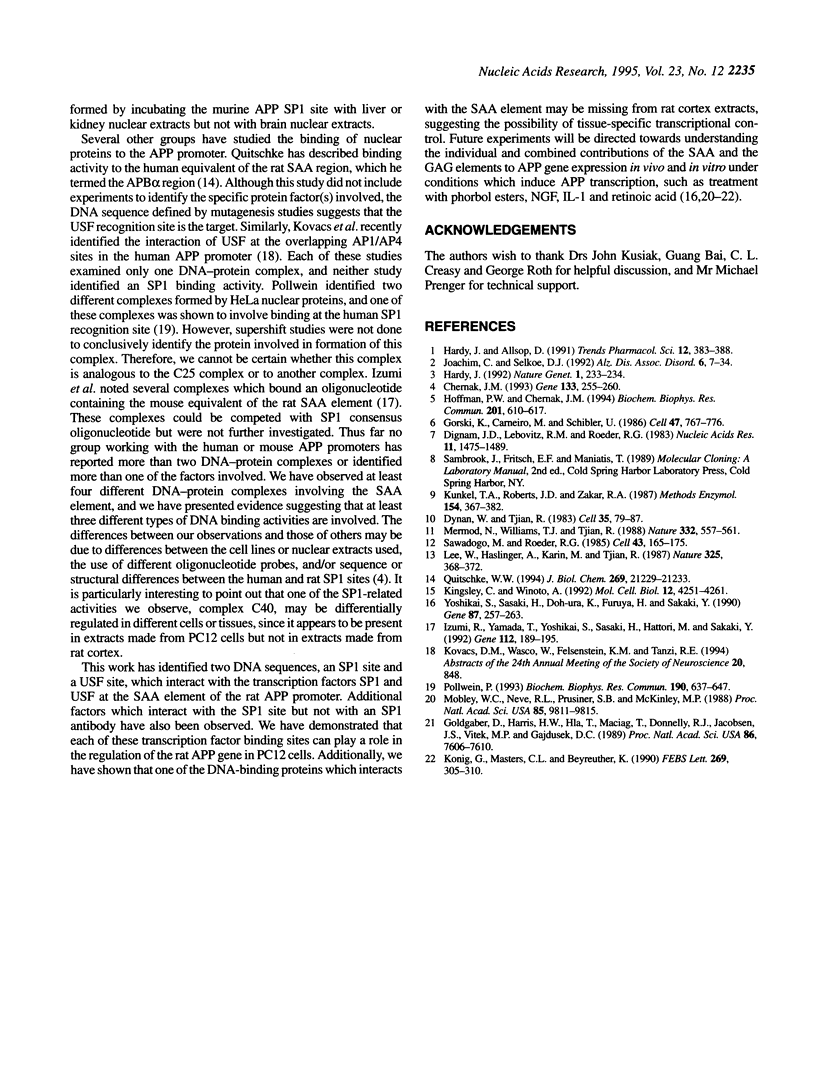
Images in this article
Selected References
These references are in PubMed. This may not be the complete list of references from this article.
- Chernak J. M. Structural features of the 5' upstream regulatory region of the gene encoding rat amyloid precursor protein. Gene. 1993 Nov 15;133(2):255–260. doi: 10.1016/0378-1119(93)90648-m. [DOI] [PubMed] [Google Scholar]
- Dignam J. D., Lebovitz R. M., Roeder R. G. Accurate transcription initiation by RNA polymerase II in a soluble extract from isolated mammalian nuclei. Nucleic Acids Res. 1983 Mar 11;11(5):1475–1489. doi: 10.1093/nar/11.5.1475. [DOI] [PMC free article] [PubMed] [Google Scholar]
- Dynan W. S., Tjian R. The promoter-specific transcription factor Sp1 binds to upstream sequences in the SV40 early promoter. Cell. 1983 Nov;35(1):79–87. doi: 10.1016/0092-8674(83)90210-6. [DOI] [PubMed] [Google Scholar]
- Goldgaber D., Harris H. W., Hla T., Maciag T., Donnelly R. J., Jacobsen J. S., Vitek M. P., Gajdusek D. C. Interleukin 1 regulates synthesis of amyloid beta-protein precursor mRNA in human endothelial cells. Proc Natl Acad Sci U S A. 1989 Oct;86(19):7606–7610. doi: 10.1073/pnas.86.19.7606. [DOI] [PMC free article] [PubMed] [Google Scholar]
- Gorski K., Carneiro M., Schibler U. Tissue-specific in vitro transcription from the mouse albumin promoter. Cell. 1986 Dec 5;47(5):767–776. doi: 10.1016/0092-8674(86)90519-2. [DOI] [PubMed] [Google Scholar]
- Hardy J., Allsop D. Amyloid deposition as the central event in the aetiology of Alzheimer's disease. Trends Pharmacol Sci. 1991 Oct;12(10):383–388. doi: 10.1016/0165-6147(91)90609-v. [DOI] [PubMed] [Google Scholar]
- Hardy J. Framing beta-amyloid. Nat Genet. 1992 Jul;1(4):233–234. doi: 10.1038/ng0792-233. [DOI] [PubMed] [Google Scholar]
- Hoffman P. W., Chernak J. M. The rat amyloid precursor protein promoter contains two DNA regulatory elements which influence high level gene expression. Biochem Biophys Res Commun. 1994 Jun 15;201(2):610–617. doi: 10.1006/bbrc.1994.1745. [DOI] [PubMed] [Google Scholar]
- Izumi R., Yamada T., Yoshikai S., Sasaki H., Hattori M., Sakaki Y. Positive and negative regulatory elements for the expression of the Alzheimer's disease amyloid precursor-encoding gene in mouse. Gene. 1992 Mar 15;112(2):189–195. doi: 10.1016/0378-1119(92)90375-y. [DOI] [PubMed] [Google Scholar]
- Joachim C. L., Selkoe D. J. The seminal role of beta-amyloid in the pathogenesis of Alzheimer disease. Alzheimer Dis Assoc Disord. 1992 Spring;6(1):7–34. doi: 10.1097/00002093-199205000-00003. [DOI] [PubMed] [Google Scholar]
- Kingsley C., Winoto A. Cloning of GT box-binding proteins: a novel Sp1 multigene family regulating T-cell receptor gene expression. Mol Cell Biol. 1992 Oct;12(10):4251–4261. doi: 10.1128/mcb.12.10.4251. [DOI] [PMC free article] [PubMed] [Google Scholar]
- Kunkel T. A., Roberts J. D., Zakour R. A. Rapid and efficient site-specific mutagenesis without phenotypic selection. Methods Enzymol. 1987;154:367–382. doi: 10.1016/0076-6879(87)54085-x. [DOI] [PubMed] [Google Scholar]
- König G., Masters C. L., Beyreuther K. Retinoic acid induced differentiated neuroblastoma cells show increased expression of the beta A4 amyloid gene of Alzheimer's disease and an altered splicing pattern. FEBS Lett. 1990 Sep 3;269(2):305–310. doi: 10.1016/0014-5793(90)81181-m. [DOI] [PubMed] [Google Scholar]
- Lee W., Haslinger A., Karin M., Tjian R. Activation of transcription by two factors that bind promoter and enhancer sequences of the human metallothionein gene and SV40. Nature. 1987 Jan 22;325(6102):368–372. doi: 10.1038/325368a0. [DOI] [PubMed] [Google Scholar]
- Mermod N., Williams T. J., Tjian R. Enhancer binding factors AP-4 and AP-1 act in concert to activate SV40 late transcription in vitro. Nature. 1988 Apr 7;332(6164):557–561. doi: 10.1038/332557a0. [DOI] [PubMed] [Google Scholar]
- Mobley W. C., Neve R. L., Prusiner S. B., McKinley M. P. Nerve growth factor increases mRNA levels for the prion protein and the beta-amyloid protein precursor in developing hamster brain. Proc Natl Acad Sci U S A. 1988 Dec;85(24):9811–9815. doi: 10.1073/pnas.85.24.9811. [DOI] [PMC free article] [PubMed] [Google Scholar]
- Pollwein P. Overlapping binding sites of two different transcription factors in the promoter of the human gene for the Alzheimer amyloid precursor protein. Biochem Biophys Res Commun. 1993 Jan 29;190(2):637–647. doi: 10.1006/bbrc.1993.1096. [DOI] [PubMed] [Google Scholar]
- Quitschke W. W. Two nuclear factor binding domains activate expression from the human amyloid beta-protein precursor promoter. J Biol Chem. 1994 Aug 19;269(33):21229–21233. [PubMed] [Google Scholar]
- Sawadogo M., Roeder R. G. Interaction of a gene-specific transcription factor with the adenovirus major late promoter upstream of the TATA box region. Cell. 1985 Nov;43(1):165–175. doi: 10.1016/0092-8674(85)90021-2. [DOI] [PubMed] [Google Scholar]
- Yoshikai S., Sasaki H., Doh-ura K., Furuya H., Sakaki Y. Genomic organization of the human amyloid beta-protein precursor gene. Gene. 1990 Mar 15;87(2):257–263. doi: 10.1016/0378-1119(90)90310-n. [DOI] [PubMed] [Google Scholar]







